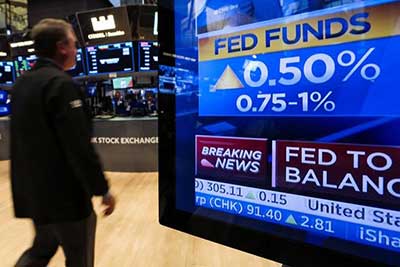Relevance: GS-3: Indian Economy and issues relating to planning, mobilization of resources, growth and development.
Key Phrases: US Federal Reserve, Capital Outflows, Foreign portfolio investors, Retail Inflation, Higher import prices, Government Borrowings, External Commercial Borrowings, Dollar Denominated Securities, Global Risk, Global Macroeconomic, Equity and Bond Markets.
Context:
- The US Federal Reserve has begun a full-fledged war against inflation with a 50 basis points hike in Federal Funds rate and commencement of balance sheet contraction from June. The repercussions of this aggressive tightening will unravel in the coming months. Regulators in emerging economies need to get ready to face heightened volatility in financial and currency markets.
How Higher Federal Bank Rates will Impact The US?
- The Federal Reserve’s move can help rein in demand in the US and reduce its outstanding debt, the impact on other economies may be far from benign. With over 50 per cent of global investors belonging to the US, low interest rates and surfeit of liquidity in the US have been fuelling global asset price inflation across markets.
- As rates begin to increase, especially at this rapid pace, capital outflows from riskier asset classes such as emerging market equity and debt will increase. A spike in US sovereign bond yields — the US 10-year bond yield is currently at 2.95 per cent — will also make portfolio money move out of emerging markets into dollar-denominated securities.
How Higher Federal Bank Rates Will Impact India Inc.?
- The Federal bank rates will impact Foreign Institutional Investments in emerging markets like India. Higher rates of interest in the US would lead to a pulling out of these investments (also called portfolio flows) from India. FIIs have been estimated to have sold more than $29 billion worth of shares in the fiscal year 2021-22 , with more than 80% sale happening between October 2021–February 2022.
- Just to get a sense of the problem, the cumulative Foreign Portfolio Investments (FPI) flow in fiscal 2021 was $3.76 billion, which has been more than offset by the FPI outflow of $4.6 billion in January 2022 alone.
- As money flows out of India, it would affect the rupee-dollar exchange rate, depreciating the rupee. Such depreciation would put considerable pressure on the already high import prices of crude and raw materials, paving the path for higher import inflation and production costs besides higher retail inflation. The Wholesale Price Index Inflation at 13.11% indicates the constraints on the supply side for India Inc.
- On the other hand, retail inflation at 6.07% in February 2022 has already breached the upper limit of the range (2–6%) set out by the Reserve Bank of India two months in a row. Higher inflation beyond the tolerance band will pose challenges to India’s economic recovery as India Inc. may find itself not having sufficient pricing power to pass on such costs.
- There is another route through which such inflation will bite India. The fiscal deficit numbers of 6.9% of the GDP set out in Budget 2022 are based on an oil price of $75 per barrel. Higher import prices of crude would send these numbers out of range, making government borrowings costlier, as also increasing the public debt to GDP ratio.
- Such a high debt to GDP ratio has been the reason for the decision of the credit rating agency, Fitch, to maintain India’s sovereign credit rating at BBB- with a negative outlook. According to Fitch: “India’s public debt/GDP ratio, at about 87% in FY21, is well above the median of around 60% for ‘BBB’ rated sovereigns.”
- It will affect the cost and also the availability of overseas finance for Indian companies. They have been looking at cheap overseas finance amid these near-zero rates to fund their capital needs, as Indian economic activity picks up.
- Thus, Indian companies have borrowed medium and long-term funds through external commercial borrowings to the extent of $31.17 billion between April 2021 to January 2022, with $20 billion coming from only 5 months. There would be considerable constraint on such financing needs as Federal bank rates are hiked. Moreover, with government borrowing rates increasing due to the poor rating of Indian sovereign debt, the rates at which the private sector can borrow abroad will further increase.
How will Federal Bank Actions Affect The Rupee?
- The rupee is impacted by three factors:
- One, the US dollar will strengthen further as interest rates of dollar denominated securities begin moving higher. This will make rupee decline.
- Two, if FPIs continue to pull money out of stock and bond markets that will weaken the rupee too.
- Three, if global risk aversion increases, money is typically pulled out of riskier assets such as emerging market assets into safe havens such as gold and US treasury instruments. This will impact rupee too.
Conclusion:
- India Inc. needs to monitor the global macroeconomic situation and its impact on its bottomline to be able to proactively withstand some of the external-induced shocks.
- The rupee has been threatening to breach the 77 mark against the dollar. That the RBI is actively supporting the rupee through market interventions is evident from the sharp drawdown in forex reserves in the last several weeks. The central bank will have to continue this intervention to buttress the Indian unit. The 40 basis points hike in domestic repo rate will help stem outflows from Indian bonds somewhat, but more rate hikes may be needed to keep pace with global interest rates.
- Regulators should also try to encourage higher participation from domestic investors in equity and bond markets. That is the only way to truly insulate our financial markets.
Source: The Hindu BL
Mains Question:
Q. Discuss the effects of the US Federal bank rates on the Indian economy. How can the RBI reduce such effects ?








